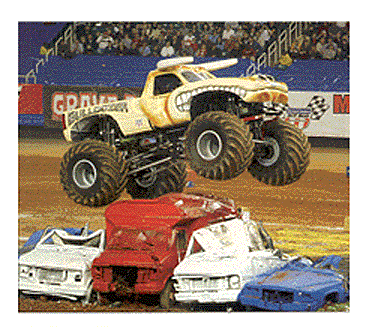
The New York City native’s journey started out as a line mechanic in NY before tackling marriage and working in Florida. It only took him a year in the sun before he returned to New York to work at the soon-to-be famous Motion Performance. His job description there was builder, tuner and driver of the famed Motion Camaro, which held the NHRA National Record in A/MP.
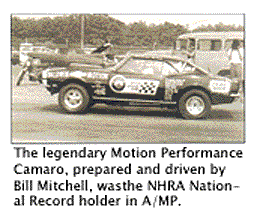
During the early ’70s, Motion Performance made cars that were more of a true performance nature than other specialty cars of the day. Today, they might be called private label race cars. While most dealers simply went for distinctive looks with graphics and wheels, Motion cars went beyond that, emphasizing the engine and suspension enhancements. That, says Mitchell, crediting the use of serious performance and racing parts in the cars, made the difference over others.
“In my opinion, they were still stock Chevrolets, though it was like a who’s who list of the aftermarket industry,” he says, referring to the use of products that were pretty much race primary in those days. More than a warmed up street car, they were, in fact, race cars sold for the street.
Even the demo car they would use to woo prospective buyers was “built,” Mitchell says, and extremely powerful. “The cars we built for the street were exact duplicates of our A/MP cars. You could take the demo and run high 10s,” Mitchell reveals. “How do I know? Many times we used the engine right out of a demonstrator in the race car.”
The muscle cars that excite many hard core collectors the most today are the Motion cars, as they were virtually the only ones to really get into the engines thereby adding to the “muscle.” Besides, a slight “bad boy” reputation never hurts a muscle car’s resale value.
Not much later, Mitchell became involved in the formation of Motion Mini-Cars and raced the popular “Thunderbug” Volkswagen gasser on the NHRA circuit often dropping into 10.90 time zones. With all that drag experience, Mitchell became a full-time racer in 1975 and won several NHRA events in Competition Eliminator.
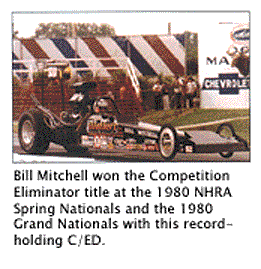
1980 was Mitchell’s most successful year as a racer, winning Comp Eliminator at both the NHRA SpringNationals in Columbus, OH, and GrandNational-Molson in Montreal, Canada. During that time, he also got involved in NASCAR Modifieds, even to the point of driving one at the historic but now defunct Islip, NY, oval track. Later, his cars would win IHRA Top Dragster and NASCAR Modified Championships in 1992. He’s been involved with the highly specialized NASCAR Mods ever since and still acts as a crew chief for one campaigned locally by Chris Young.
Of course, no discussion of Bill Mitchell’s racing successes would be complete without looking at the engine parts and components he has developed for the aftermarket. In 1976, he founded Bill Mitchell Products and began selling “hard core” racing products to competitors, while continuing to race.
By 1985 Mitchell’s engine parts business had grown to the point where it commanded his full attention and he put his personal racing on the back-burner. World Products was formed, and in 1987 introduced its first high performance cast iron head.
In 1988 Hot Rod magazine named World’s small block replacement head “Product of the Year.” In 1990 World introduced the “Merlin,” a high performance big block Chevy replacement that was the first aftermarket cast iron block.
Monster Truck Motors 101
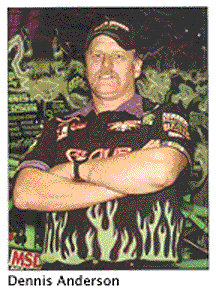
For years, Mitchell’s World Products’ main marketing thrust was drag racing and marine engines but a side trip into Monster Trucks ended up making the Merlin block a virtual “standard” of the Monster Truck industry. Today, most of the field at a Monster Truck show uses Merlin III iron blocks and aluminum cylinder heads. One of the first to switch to the Merlin was Dennis Anderson and his famous “Grave Digger.”
Monster Truck competitions, also known as “Monster Jams,” primarily orchestrated by media giant Clear Channel Communications, play to arenas all over North America. They’ve recently expanded to Europe where a multi-truck circuit is performing to excited capacity crowds. This increase in locales and markets will add greatly to the visibility of the trucks but also make their working conditions much more variable – something Mitchell closely keeps his eye on.
That’s because World Products doesn’t just supply some of the parts found in a Monster Truck motor, they actually build many, if not most, of the engines. And with over 130 trucks on the Clear Channel circuit, that’s a lot of engines.
Monster Truck motors are best compared to Alcohol Funny Car engines in their construction and components, but are not run as strong. Where a Top Alcohol Funny Car will generate 2,200 to 2,500 horsepower, a Monster motor, listed as a Merlin Powerplant, will have 1,400 horses. But while they may not be built “on the edge” with regard to their components and technology, Mitchell says the difference is “mostly the attention to detail for reliability and no expense is spared to that end.” Less power ensures reliability.
Monster Trucks are designed more for shows and reliability than for pushing the envelope on speed and motor technology. The 540 cid powerplants for the 10,000 lb trucks must be exceptionally reliable, as they’re expected to have a two-year service life despite operating under a wide variety of climates and conditions. While most race engines run in warm or at least consistent weather and are built to operate in that range, Monster Trucks are faced with a more difficult set of circumstances.
One example of those challenges is cold weather starting. Due to emissions and health considerations, Monster Trucks are typically parked outside the enclosed stadiums they appear in during the winter months. Sometimes that means sub-zero temperatures and hard starting at best or a chance for freezing at worst.
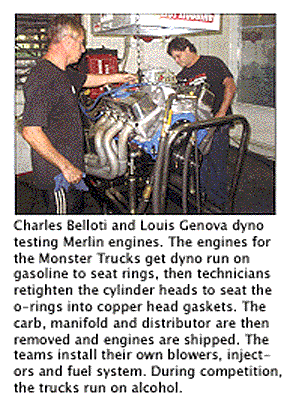
The enlarged water jackets that are part of the Merlin III blocks are said to enhance the engines’ cold weather operation. They work because the heads of the alcohol supercharged engines retain heat in the chambers.
Because they race and perform virtually on cue, the trucks must start easily – and flawlessly – time and time again. An example of what CAN’T go wrong at a Monster Truck show is something as simple as a leak. If a team didn’t have the time or parts to fix something that leaks at a show, the show does not go on. Therefore, more time is spent on things like freeze plugs and water jacket connections during building.
Reliability is the builder’s number one priority, because the motor HAS to survive. “The thing has to make the distance,” Mitchell explains, “so builders basically spend more time during the build.” There may be nothing in those engines that’s on the edge, but careful attention is paid to every detail for durability.
Mitchell says the motors usually take twice as long to build as many race engines. It often takes two days to complete one engine, fitting and assembling the prepped parts before ending up on the dyno.
The first day’s construction process is spent building the short block, including degreeing the cam and may include buttoning up the pan of the wet sump system. The second day sees the rest of the motor go together as well as some quality dyno time. But these dyno pulls are not intended to see what kind of power or torque the motor has. In fact, World’s engine builders don’t even check power and torque figures.
Although alcohol is the fuel used during competition, which includes racing the trucks over things like motorhomes and hapless stacks of cars, when a Monster Truck motor first breathes life at World, it’s with gasoline and a carb. Then engineers begin a break-in process on each engine that will help seat the valves and rings, and cycle the heads and their gaskets. They also re-torque the head bolts to seat the O-rings into their receiver grooves in the block.
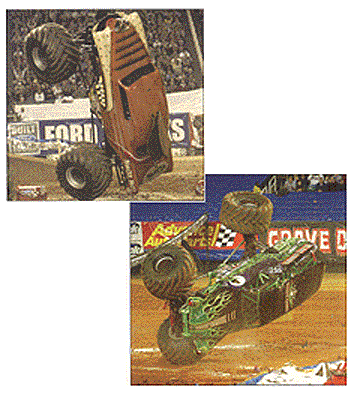
Two hours of warm up are followed by a cool down period then repeated for three or four dyno pulls, then cool down again. The process may happen as many as four times before the techs take off the distributor, intake and carburetor and pack up the long blocks in wood crates for the trip to North Carolina and Richard Midgete’s handiwork at SFX Motorsports.
Street engines with fewer cubic inches and only so many hardcore parts typically run compression ratios of 8: or 8.5:1 with blowers. So with bigger cubic inches and all hardcore pieces, just what is the compression of a Monster Truck Merlin Powerplant? “Not as low as you think,” laughs Mitchell as he stonewalls any attempt to uncover Merlin compression secrets.
Teams using the blowers typically run them at the 10 percent mandated by the rules but often run less and always adjust for track tuning. When asked if the motors are unique to Monster Trucks, he says, “No, I would have to say they’re very conservative.”
The motors are more about being identical for changeability from one truck to another more than anything else, Mitchell says. “And that bugs Dennis Anderson (driver of the Grave Digger). He literally begs for more power and they don’t give it to him,” Mitchell laughs.
While Anderson may not always get what he asks for with regard to power, he does, however, try to make sure other Monster Truck teams get what they need, giving direction to his former – but in a way, still current – engine builder, Richard Midgete. The trucks need low-end torque for wheelies, climbing and crushing and Anderson interacts with Midgete on what the truck drivers need. If you’ve watched Monster Trucks for all their years, you’ve surely noted how they seem to have more power these days, mostly visible by the increased number of activities they now perform from power wheelies to climbing motor homes. The idea is have power where the driver needs it to perform all those wacky stunts.
Midgete, who runs the series’ engine shop in North Carolina finishes off each new engine and then later freshens them as well. He periodically oversees production and assembly of the new ones at World, too. Mitchell gives him high marks and describes him as the “key guy in the Clear Channel engine program.” He proudly states, “Out of everybody involved in the whole deal, I just can’t give enough credit to Dennis Anderson and Richard Midgete. They absolutely are the whole deal.”
Parts Development
Building winning engines for so many years has given Mitchell quite a bit of experience in recognizing the relationship between durability and power. Durability, says Mitchell, is really understanding where an engine is NOT durable. “Knowing where they crack and are weak under power is key,” he says. “You need to know where they tend to break when used with superchargers and so forth. It’s a difference from a street engine shop to a race engine shop.”
It comes down to usage and any restrictions that may be in place. Mitchell says because his parts are designed for performance only they don’t have to match the OEM pieces completely. “We have no reason to make something just like a Chevrolet,” says Mitchell, citing a typical problem in Chevy race engines with the head gaskets blowing out under the increased compression and pressure of today’s racing environments. When he designed new heads to go with one of his blocks, he could have added two more head bolts.
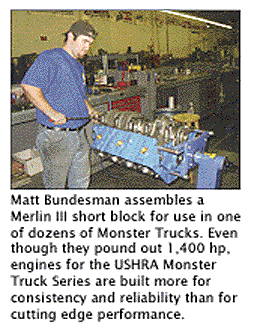
But there’s always a limit to changing that basic design, he acknowledges. “You’ve still got to be able to bolt stock stuff to it,” he says. “It may sound simple and effective to add two more head bolts, but what about ancillary parts such as gaskets, stud girdles, pushrod paths and even valve covers? All have to be factored in.”
When it comes to building power into a block, it’s again a matter of knowing what the finished piece is going to be used for. If it’s racing, chances are, the customer will want to make it bigger so the pieces are made with that in mind.
“We make the parts so you can build your engines as big as possible. Bigger is better,” Mitchell says.
Does that mean we will be seeing a 500 cid World small block anytime soon? After all, he’s already selling 454 cid small blocks as part of his extensive crate motor line. “No, everything has sort of a limit,” Mitchell says. “A 500 cubic inch small block would not be able to take on stock, bolt-on parts.”
While building parts for the extreme levels of performance may be exciting, Mitchell says only a small percentage of his customers actually ask for those parts, comparing the performance engine market to a weekend drag race. There are always some ultra high performing Top Fuel and Pro Stock-type race cars, but the vast majority of cars waiting in the inspection lines on opening day are the “mostly stock” classes. “We like making parts for the long lines,” he laughs.
For Bill Mitchell, from Motion to Monster Trucks, it’s all about the motors.













